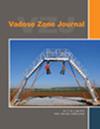灌溉安排需要同时考虑植物可利用水量和土壤通气要求
IF 2.8
3区 地球科学
Q3 ENVIRONMENTAL SCIENCES
引用次数: 0
摘要
依靠农业灌溉进行的全球粮食生产占全球淡水消耗量的 70%。全面了解土壤水特性(SWCs)以及土壤和底土中的土壤水临界值对于有效管理灌溉用水非常重要。对植物而言,临界土壤水 "窗口 "通常是指植物可利用的水量窗口,而不考虑以扩散为主的土壤通气性这一共同前提条件。本研究考察了八种牧场土壤中伏流土壤剖面(最深 1.5 米)的 SWC 曲线。使用拉力台和压力板仪器在-1 到 -1500 kPa 的母质电位范围内进行了土壤水分测量。我们使用 van Genuchten 模型对测得的 SWC 曲线进行参数化,同时使用 Millington-Quirk 模型从测得的土壤物理特性推导出土壤-气体扩散率。我们根据植物可利用水分和土壤气体扩散率的临界值定义了临界土壤水窗口,以确保植物生长所需的水分和通气核心条件。结果明确区分了所选剖面中重力水、植物可利用水和不可利用水的深度依赖机制,以及它们对整个深度土壤结构变化的响应。在一些观测到的土壤剖面中,植物仅能利用 30%-60% 的植物可用水窗口,因为其余部分的土壤通气条件不足以满足植物生长的需要。此外,模拟灌溉条件下两种选定土壤的渗透剖面突出表明,事先了解较深土层的土壤结构对安排灌溉非常重要。本文章由计算机程序翻译,如有差异,请以英文原文为准。
Irrigation scheduling needs to consider both plant‐available water and soil aeration requirements
Global food production relying on irrigated agriculture accounts for >70% of the global freshwater withdrawal. A thorough understanding of soil–water characteristics (SWCs) and critical soil–water values in the soil and subsoil is important for effective management of irrigated water. A critical soil–water “window” for plants is generally taken as the plant‐available water window without considering diffusion‐dominated soil aeration as a co‐requisite. This study examined SWC curves in vadose soil profiles (up to 1.5‐m depth) in eight pasture soils. The soil moisture measurements were made over matric potentials ranging from −1 to −1500 kPa using tension table and pressure plate apparatus. The van Genuchten model was used to parameterize the measured SWC curve, while the Millington‐Quirk model was used to derive soil–gas diffusivity from measured soil physical properties. We defined critical soil–water windows considering the threshold values for both plant‐available water and soil–gas diffusivity to ensure water and aeration corequisites for plant growth. The results clearly distinguished depth‐dependent regimes of gravitational, plant‐available, and unavailable water in selected profiles and their responses to soil structural changes across the depth. In some of the observed soil profiles, only 30%–60% of the plant‐available water window was able to be utilized by plants because the remainder existed under soil conditions where soil aeration was inadequate for plant growth, emphasizing the importance of considering both the plant's water and aeration requirements during irrigation scheduling. Further, the infiltration profiles in two selected soils under simulated irrigation highlighted the importance of a priori knowledge of the soil structure in deeper soil layers for scheduling irrigation.
求助全文
通过发布文献求助,成功后即可免费获取论文全文。
去求助
来源期刊

Vadose Zone Journal
环境科学-环境科学
CiteScore
5.60
自引率
7.10%
发文量
61
审稿时长
3.8 months
期刊介绍:
Vadose Zone Journal is a unique publication outlet for interdisciplinary research and assessment of the vadose zone, the portion of the Critical Zone that comprises the Earth’s critical living surface down to groundwater. It is a peer-reviewed, international journal publishing reviews, original research, and special sections across a wide range of disciplines. Vadose Zone Journal reports fundamental and applied research from disciplinary and multidisciplinary investigations, including assessment and policy analyses, of the mostly unsaturated zone between the soil surface and the groundwater table. The goal is to disseminate information to facilitate science-based decision-making and sustainable management of the vadose zone. Examples of topic areas suitable for VZJ are variably saturated fluid flow, heat and solute transport in granular and fractured media, flow processes in the capillary fringe at or near the water table, water table management, regional and global climate change impacts on the vadose zone, carbon sequestration, design and performance of waste disposal facilities, long-term stewardship of contaminated sites in the vadose zone, biogeochemical transformation processes, microbial processes in shallow and deep formations, bioremediation, and the fate and transport of radionuclides, inorganic and organic chemicals, colloids, viruses, and microorganisms. Articles in VZJ also address yet-to-be-resolved issues, such as how to quantify heterogeneity of subsurface processes and properties, and how to couple physical, chemical, and biological processes across a range of spatial scales from the molecular to the global.
 求助内容:
求助内容: 应助结果提醒方式:
应助结果提醒方式:


